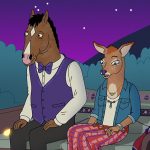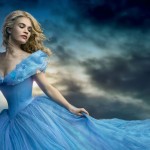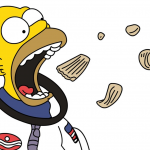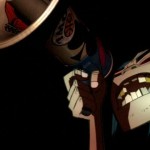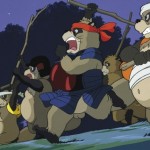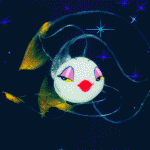Nathanael Smith meets Song of the Sea director Tomm Moore
Support independent, non-corporate media.
Donate here!
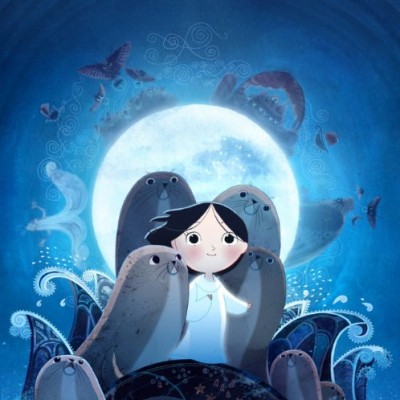
Product : Why do you persist with hand drawn animation?
There’s a few reasons, you know. One thing is fairly simple, in that I remember a few years ago I had a friend who was working at Aardman, and they’d done a test for Chicken Run, and they’d showed they could make it look almost exactly like claymation, but with computers. It had thumb-prints on, and stuff like that. I remember someone said that Nick Park said, “but what’s the point, I just want to play with plasticine.” It’s the process that he cared about. I think he had a good point. It’s how you spend your day. I do like to spend my day focussing on drawing and painting, if I could do that for the rest of my career I’d be happy.
But I think there’s another good reason: hand drawn animation has such a timeless quality. Even though we use computers a lot to help the film get made within the budget and time that we’ve got, we still stick to that very traditional look. Everything starts and ends with watercolours and paper. I think that means that the film won’t age in the same way that it would if we’d made it with new, shiny software. ‘Cause when I look at some of the older CG films, from about 10 years ago, the software has moved on so much, you can see that they’re old. Yet when I look at older hand drawn films like My Neighbour Totoro and then something like Ponyo, and they are made 20 years apart yet they just feel timeless.
Over the credits, you play parts of the storyboards and different stages of the animation process. Was that a tribute to the medium?
Yeah, and to the crew as well. Right now we have a big exhibition on in Kilkenny Castle, where our studio is – just trying to show all the work that goes behind it. Because what’s on that screen is at the end of a process. Prior to that there’s great artwork that nobody gets to see, so it’s nice to show it in the credits. And also, I think I took a leaf out of Laika’s book. They made a point out of showing people that this is hand made. So we showed the process, we showed the drawings unaltered by any digital compositing. We tried to link the credits up with it, as they went past, so when each member of the team came up it would be their work that we were showing. It doesn’t quite link up, but that was the aim.
Were Ben’s retro 3D glasses almost a comment on the distinctly 2D nature of the film?
You know, it’s funny, I did a screentest of the stereoscopic 3D with the 2D animation, I thought it looked great, like a pop-up book. But not everyone was as convinced as I was… So I thought if it had gone 3D it might have looked cool, and it might have been another way to reinvent hand drawn animation, to show the people it in a way they hadn’t seen before. But we did a cool test, and that’s all.
The 3D glasses were also a throwback to my childhood. The film is set in 1987, when both myself and Will Collins, the screenwriter, we remember the 3D craze that year, especially at Halloween. I remember the Irish broadcaster RTE were showing 3D horror movies, and everyone wanted to get a pair of glasses, so we were all fighting over these cheap, cardboard green and red glasses. We put that in there just as a tip of the hat to that. Now, of course, kids go to the cinema and part of the fun is not just the popcorn, but getting to wear their funky, 3D glasses.
How do you go about designing the aesthetic of a film like Song of the Sea, where no single frame is wasted? What’s your starting point?
It’s a bit of a refining process, because we obviously storyboarded and designed a lot more than ever ends up in the film. So it starts off with just concept art and sketches, we do a lot of brainstorming at that point. Then when we’ve got the script and story locked down, we have to select from that and it gets refined there. It’s going through a refining process as you go through each step and at the end, when we have the film locked and we know that’s the film we’re gonna make, we do a pass where every single scene gets really carefully designed, just in black and white. We make a colour script as well, where we pick the colours, very broadly, before going to the background painters and the layout team.
Were there any visual influences that you drew on? With The Secret of Kells, it was influenced by the book of Kells itself. What imagery did you draw on (sorry!) for this?
It was a bit broader with this. We knew we didn’t have to reference medieval art or anything, and we kind of wanted to avoid making it a lot like that picture. Although a lot of people have said this looks like The Secret of Kells, but for me Kells was almost like a stained-glass window, or illuminated scripts. Everything had a kind of hard line around it, for this we wanted something softer. We used a lot of aerial perspectives. We looked at stuff like Paul Henry’s landscapes, he was a landscape painter in Ireland at the turn of the twentieth century.
A funny thing that happened was, Fabian Erlinghauser, the Art Director, when I was showing them all these Pictish carvings and rocks that were pre-Celtic, he saw them and thought of Klee and Kandinsky and modern artists, which is a connection I never would have made. So we started looking at some modern art. There’s almost a certain cubist element to it.
The first time Saoirse goes under the sea, I could see a definite Kandisky influence there.
Yeah, it’s crazy stuff. We liked playing with animation techniques that are kind of unique to hand drawn animation, too. Something that’s like a little mission statement within our group in the studio, where we’re saying ‘let’s do something that would be very difficult or impossible to do in CG.’
What do you think the role of mythology is in today’s culture? Are we now too cynical for myths?
I think people are mad for it, it’s everywhere. When you really look at it from the broadest point of view, like Joseph Campbell’s kind of idea about mythology and the monomyth and all, all the superhero films that are in the cinema at the moment and all the animated films based on that kind of structure, use those tropes more than ever. It’s kind of interesting to me to look at it through that kind of lens rather than the purest form of myth.
I don’t think that’s where mythology and folklore really live, in academia or in dusty old books or even in the tacky stuff that you see in tourist shops. It’s in the vernacular, it’s what people are interacting with. What we wanted to do with Song of the Sea was kind of wake it up a bit, make it something accessible to kids in a natural and entertaining way, something that they interact with in a very natural way. I guess because Song of the Sea is drawn directly from really old folklore, it feels a little more linked to it, but I think the underlying structure is very similar to a lot of modern adventure films.
In terms of wanting to make it accessible to children, in Song of the Sea the magical and the real worlds echo each other – do you see stories as a form of explanation? Or catharsis?
Yeah, for me narrative is definitely how I understand the world. We all tell ourselves stories about how did this happen, or how did that happen, especially when you are dealing with something complicated, putting it into the context of a narrative and making it go from being something that’s shocking and experiential, like a loss or a bereavement, and then being able to make sense of it through whatever narrative makes sense to you. I think that’s what stories are, they are how we think about things and how we relate to each other.
I suppose Jesus always told stories in parables…
Yeah, that’s what I’m saying – it’s allegories and metaphors. If you think about why we have so many, not just children but people of every age, relating to these superhero stories, there’s still that kind of power of metaphor in ancient gods and heroes, and this is just the current incarnation of them, you know?
There seems to be quite a lot in your work that looks at the relationship between Christianity and traditional Irish mythology. How do you see the relationship between the two?
That was an eye opener for me, and the way into understanding mythology for me. I grew up in a Northern Irish household, transplanted to the Republic of Ireland; my parents are Northern Irish Catholics, we were raised pretty strictly as Catholics. But it’s impossible to ignore that Catholicism puts a veneer over an older belief system. We’d go to mass at a holy well, and the holy well would be surrounded by all these carvings, showing that the place was sacred long before Christianity. That was interesting to me. I started looking at how, at least in Ireland though I think it’s all over the world, there are beliefs and folklores that got built on by whatever the next worldview or narrative was, but they were obviously relating to something that people needed. There was a truth that everyone needed, a way of understanding the world that people held on to, and it just got built one on top of another. These sacred sites, on one level they are Catholic, on another level they are pagan, and they’ve obviously been sacred for a long time. It helps people to think like that, that they are just the latest veneer, or it might be reactive, when this is something that goes back through a lot of human history.
I think about my Grandmother’s time, and the belief system in her period, and what was kind of amazing was that she was a very strict Catholic but at the same time believed in fairies and a load of other superstitions.
Do you see it as a way of keeping older stories alive, by highlighting these layers of history?
I hope so. It’s not, like, a mission, it’s just something I find fascinating and really makes sense to explore whenever you are working outside of the mainstream, when you are able to show people something else. I like linking it to the mundane, and the every day. It’s very close to home, it’s not off set on a crazy other planet, it’s just up at the roundabout. It kind of connects you to your ancestors, the people that went before.
Another tension I noticed is between humans and nature in both films. I didn’t want to be clichéd, but when he passed Ben Bulben I immediately thought of Yeats…
Well, yeah, there’s a Yeats quote at the start of the film…
There seemed to be a Yeatsian call to the countryside when the kids arrive in the city. Do you think we are losing our connection to nature and, as a result, the past?
Yeah that’s something I was thinking. It was a long time ago that I started thinking up the film, and we were just in the early throes of the Celtic Tiger (a period of economic growth in Ireland) and it occurred to me that my son would grow up in an Ireland that was fairly divorced from what I had experienced and it was becoming more and more global. I just thought that there was something to talk about there.
I think that there is a natural draw in everybody towards an almost idyllic idea of a bucolic past. So I liked to play with that, and even to show some things that I noticed in the countryside as a kid growing up, where you would see right in the middle of a beautiful fairy fort, someone had dumped an old washing machine, I wanted to point at that.
I guess the countryside is tied up with the fairy folk. As you see the fairy magic fading in the film, is it a warning?
I wouldn’t say it’s a warning, more a way to remind people to keep it going. That’s the whole purpose of the film, when the mum told Ben to keep remembering in stories and songs, she was speaking to all of us. I liked having a fairy fort in the middle of the city, too, because I feel it’s everywhere, I don’t think it’s that far away from anyone. That’s why we put a little island on the roundabout.
Irish cinema seems to be in good health at the moment – or at least the stuff I’m seeing is generally excellent. The McDonaghs, Frank, some respected horrors, a wee film called Grabbers. How do you see the industry in Ireland at the moment?
I think it Irish cinema is in good health creatively, good stuff is getting made, it’s getting people to watch it that’s the challenge, and convincing people that it’s worth the price of a cinema ticket as much as the next Hollywood blockbuster. I think that’s what all the artists in Ireland are talking about at the moment, that’s the next step for us. We’ve got to the point where we are proud of it, we’re making good stuff, it’s just getting the average audience to support it.
But it’s a good moment, especially in live action. I’m a fan of Lenny Abrahamson’s films. He’s coming from a different point of view, he’s got a philosophical background and came into film making that way.
Finally, as this interview is for a column dedicated to animation, what have you been watching and enjoying recently?
Oh wow. Well, I love everything. I’m really looking forward to Inside Out, I haven’t seen that and I’ve been trying to avoid publicity for it, but I’ve heard good things…
I’ve seen it twice, it’s excellent.
Well don’t tell me any more than that. I’ve made friends with Pete Docter, around the time of Secret of Kells when we were both nominated (Docter was nominated for Up) at the same time and we’ve kind of kept in touch. I’m really curious to see what he’s been cooking up. So I’ll see it in Galway at the end of the week.
The film that really opened my eyes and really made me do a bit of soul searching was Princess Kaguya from Takahata. He was using animation… I’ve been waffling on about what can 2D animation do, and he delivered a masterclass in how even the way the characters are drawn, with the lines, can express something, and I want to take that into my own work, going forward. Maybe one of the masterpieces of Ghibli. It’s a really exciting work.
Such a shame that it’s probably his last film as well.
Yeah, I know. If you watch any making of documentaries with Ghibli, it’s kind of a running joke about how long it takes him to make a film. But he might make another, you never know.
Do you see yourself as a kind of spiritual heir to Ghibli, given that there are so few film makers working with traditional, hand drawn animations? They’re kind of kin, even though they’re oceans apart.
I’m flattered, because I’m a huge fan. It’s nice to have people say that, and it’s nice to have something to point to when people ask you ‘what kind of thing are you doing?’ We also have the same distributors in the US and the UK, so there is definitely a connection and overlap with the audience. But I think I’m a long way off them, I’ve only got two films under my belt, so I’m not quite an heir yet.




